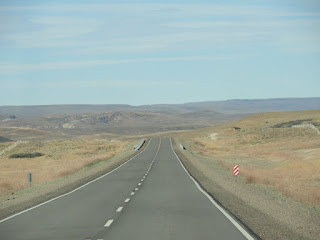Today we are going to Rosairo, the third biggest city in
Argentina, as we continue our big city acclimatisation in preparation for
Buenos Aires. One good thing about
travelling between these big cities is that they are linked by motorways, and
the times on the busses are short. To
avoid the heat we have arranged an afternoon bus so that we can pass the hot
hours away in air conditioned comfort.
Because of the late departure we have time to spend blogging and sorting
out photos before we head to the bus station for our 14:00 departure.
Except it isn’t 14:00, it is 14:30 but we miswrote the time down in our notebook. So we actually are an hour early when we arrive. And like so often happens, being early almost causes us to miss the bus because we aren’t paying enough attention to what is happening (namely our bus is not the bus company we were told it would be but another one instead). Still we get the bus, and begin the trip to Rosario.
The trip itself begins well, as we speed down the motorway, but all too soon we are off the motorway and stopping in a small town. And this is when we discover the second miscommunication about this bus, we thought it was an express, getting to Rosario at about 19:30, it is actually a stopping everywhere bus, getting there at 20:45. There is nothing to do but sit back and watch the rubbish film (Conan the Barbarian).
Because of the time delay when we get to Rosario all we can do is get a taxi to the hostel we are staying in, check in, and find the nearest place to eat. This turns out to be a pizza place around the corner. Now there are some who claim that pizzas in Argentina are even better than in Italy or the US, but so far they have been good but not outstanding. That is until now, as this pizza is one of the best I have ever had. We had a half and half, one with ham, chees, an egg and peppers, and the other with mince and sweet corn, and both were amazingly good, and not too dear. Despite the fact that I never actually ate pizza in the US or Italy, I can see how some people can make this claim.
Except it isn’t 14:00, it is 14:30 but we miswrote the time down in our notebook. So we actually are an hour early when we arrive. And like so often happens, being early almost causes us to miss the bus because we aren’t paying enough attention to what is happening (namely our bus is not the bus company we were told it would be but another one instead). Still we get the bus, and begin the trip to Rosario.
The trip itself begins well, as we speed down the motorway, but all too soon we are off the motorway and stopping in a small town. And this is when we discover the second miscommunication about this bus, we thought it was an express, getting to Rosario at about 19:30, it is actually a stopping everywhere bus, getting there at 20:45. There is nothing to do but sit back and watch the rubbish film (Conan the Barbarian).
Because of the time delay when we get to Rosario all we can do is get a taxi to the hostel we are staying in, check in, and find the nearest place to eat. This turns out to be a pizza place around the corner. Now there are some who claim that pizzas in Argentina are even better than in Italy or the US, but so far they have been good but not outstanding. That is until now, as this pizza is one of the best I have ever had. We had a half and half, one with ham, chees, an egg and peppers, and the other with mince and sweet corn, and both were amazingly good, and not too dear. Despite the fact that I never actually ate pizza in the US or Italy, I can see how some people can make this claim.








































